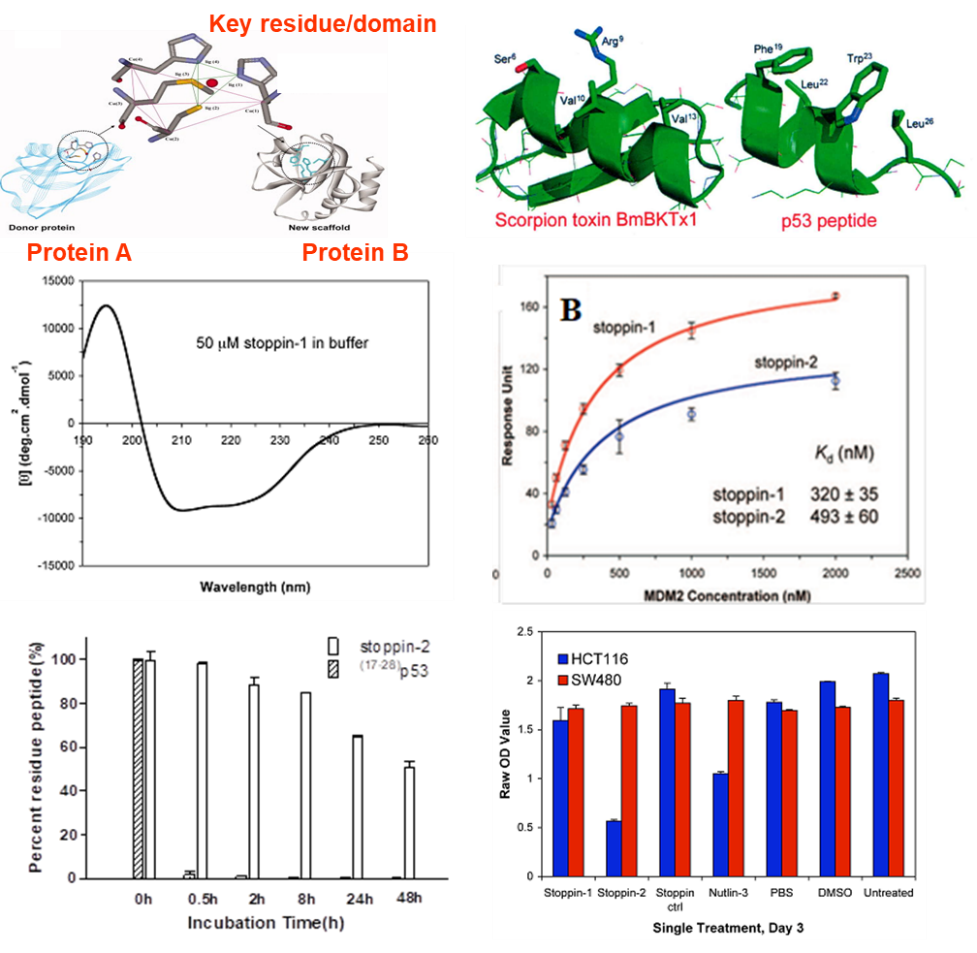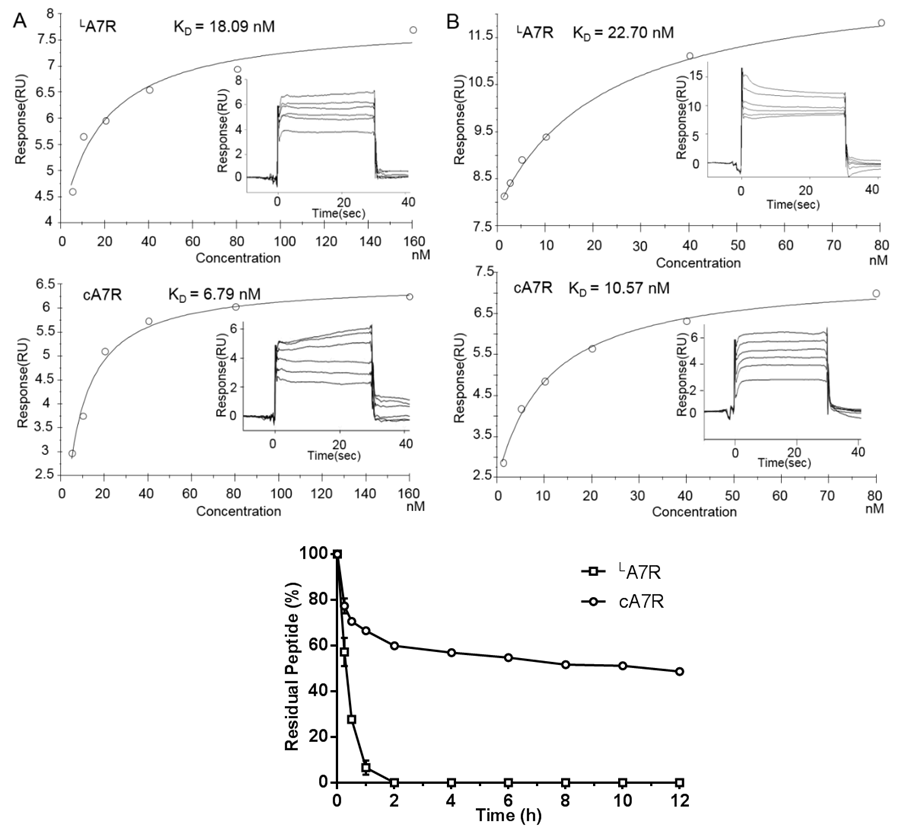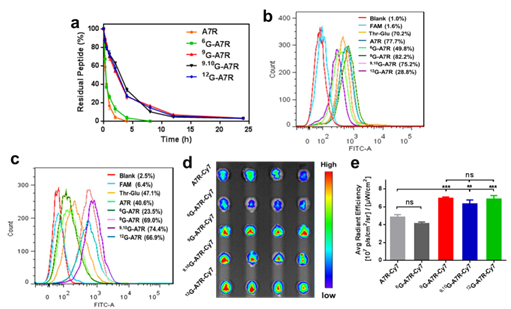Targeted peptide molecular design and stabilization technology
1.1 Targeted peptide molecular design technology
It has a targeted peptide molecular design technology platform based on phage display, computer-aided design, protein "grafting", fusion peptide, solid phase peptide synthesis, natural fragment splicing and other technologies. Using this technology platform, new targeted peptide molecules can be designed. The constructed targeted peptide molecules include tumor targeted peptides, brain targeted peptides, and tumor targeted therapeutic peptides.
Example: Protein "grafting" design of p53 activating peptides
Taking the natural p53 sequence as the mock object, and the scorpion venom BmBKTx1 as the template, the key site of p53 binding to MDM2 was "grafted" onto the scorpion venom micro protein. Through molecular level characterization, the designed product stoppin-1 can specifically bind to MDM2, and has the ability to inhibit the binding of p53 and MDM2; Further drawing on the principle of cationic transmembrane penetrating peptides entering the cell, a micro protein stoppin-2 with transmembrane penetrating ability is designed. The obtained stoppin-2 has good stability and can selectively kill tumor cells by inhibiting the binding of p53 to MDM2 (Figure 11).

Figure 11. Design, Construction, and Characterization of Stopin
Related patents:
1. Lu Weiyue, Ran Danni, Mao Jiani, Xie Cao; VAP peptides and their applications in targeted tumor diagnosis and treatment (201611151911, authorization date March 18, 2022; PCT/CN2017/114796, application date December 6, 2017; AU2017372268, notified by the Australian Patent Office; 2019-528582, notified by the Japanese Patent Office), implemented in September 2019, with a license amount of 30 million
2. Liu Min, Xie Zuoxu, Lu Weiyue, Xie Cao, Li Xue; Polypeptide with bradykinin receptor binding activity and its use (2014101995676, authorized on October 8, 2019)
3. Lu Weiyue, Ruan Huitong, Xie Cao; Multifunctional Targeted Peptide RAP and Its Application in Tumor Targeted Delivery (2017107687884, Authorization Date March 7, 2022)
4. Lu Weiyue, Zhaqiya, Xie Cao, Hu Xuefeng; A multifunctional targeted molecule and its use (2016100776577, authorized on June 9, 2020)
5. Lu Weiyue, Zhan Changyou, Xie Cao, Meng Qinggang, Gu Bing; A brain targeting peptide mediated by acetylcholine receptor and its application (2010101412180, authorized on July 10, 2013)
6. Lu Weiyue, Ran Danni, Xie Cao, Zhan Changyou, Mao Jiani; Whole process targeted peptides and their application in the construction of tumor targeted diagnosis and treatment delivery system (2017106840088, application date August 11, 2017)
1.2 Targeted peptide molecule stabilization technology
Conventional peptides are usually composed of L-shaped amino acids and are easily hydrolyzed by proteases in the body. They often cannot maintain their biological activity stably for a long time in the body, which affects the targeting efficiency or therapeutic effect. Therefore, stabilizing peptides is an important means to improve their in vivo effects. In this regard, we have targeted peptide molecule stabilization technology platforms based on reverse sequence inversion technology, mirror phage display technology, stacked peptide technology, glycopeptide and cyclic peptide technology, etc. A series of stable targeted peptide molecules were designed and constructed using this technology platform, including the use of reverse sequence inversion technology to design stable peptide target molecules composed of multiple all D-configuration amino acids (tumor targeted peptides: DA7R and DVAP, etc.; brain targeted peptides: DCDX and Dangioep, etc.); Using mirror phage display technology, we designed a p53 activating peptide with high binding activity and good stability in full D configuration of tumor related proteins MDM2 and MDMX; The stapped polypeptide technology was used to design the anti-tumor polypeptide stapped PMI and multifunctional brain tumor targeting polypeptide stapped RAP, which not only improved the stability of polypeptide, but also enhanced the transmembrane transport capacity of polypeptide; The A7R glycopeptide was designed using glycopeptide technology, which not only improves the stability of the peptide but also enhances its brain targeting function; Stable tumor targeting peptides such as cA7R were designed using head tail cyclization technology.
Example: A7R peptide stabilization design
A7R polypeptide has high binding activity with VEGFR2 and NRP-1, which can target brain tumor cells, tumor neovascularization and break through the blood brain tumor barrier, but A7R polypeptide plasma has poor stability. By using natural chemical splicing technology, A7R cyclic peptides were synthesized, which were cyclized through amide bonds. Not only did they retain high binding activity with receptors, but their stability in plasma was also greatly enhanced (Figure 12).
By using solid-phase synthesis method, a N-terminal glycosylated peptide A7R was synthesized. The results showed that the stability of glycosylated A7R in plasma was significantly enhanced, and its in vivo and in vitro targeting properties were enhanced (Figure 13).

Figure 12. Binding activity of A7R cyclic peptide to receptor and stability in plasma

Figure 13. Stability and in vivo and in vitro targeting evaluation of A7R glycopeptides in plasma
Related patents:
1. Lu Weiyue, Wei Xiaoli, Zhan Changyou; A D-configuration peptide mediated by acetylcholine receptor targeting and its application (2013105l31974, authorized on December 7, 2017)
2. Liu Min, Wang Ruifeng, Lu Weiyue, Xie Cao, Li Xue, Wang Jing; A D-configuration peptide (2017104341564, application date June 9, 2017)
3. Lu Weiyue, Wang Huan, Xie Cao, Li Huan; A7R Glycopeptide and Its Use in the Preparation of Tumor Diagnosis and Treatment Drugs (2018105556623, Application Date May 31, 2018)
4. Lu Weiyue, Ying Man, Xie Cao, Gao Jie, Wei Xiaoli, Zhang Mingfei, Song Xianfei; Stable A7R peptide and its use in constructing tumor targeted diagnosis and treatment delivery systems (2016101505248, application date March 16, 2016; PCT/CN2016/101738, application date October 11, 2016)
5. Lu Weiyue, Chen Xishan, Xie Cao, Ruan Huitong; Stapled RGD peptide and its application in tumor targeted delivery (201510772430X, application date November 12, 2015)
6. Lu Weiyue, Wei Xiaoli, Zhan Changyou, Xie Cao; A Stable Peptide Mediated Multiple Targeted Drug Delivery System for Brain Tumors Across Barrier Membranes (201510404486X, Application Date July 10, 2015)
7. Lu Weiyue, Wang Fei, Wu Meilin, Xie Cao, Zhang Xiaoyu, Gao Jie; C (LyP-1) peptide and its constructed nanodrug delivery system and application (2013103344177, application date August 2, 2013)
 Home
>
Business
>
Tayzen
>
Targeted peptide molecular design and stabilization technology
Home
>
Business
>
Tayzen
>
Targeted peptide molecular design and stabilization technology










